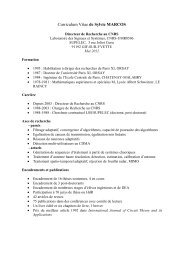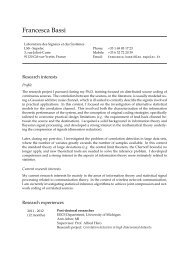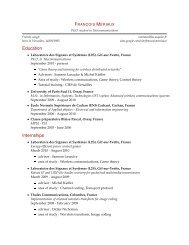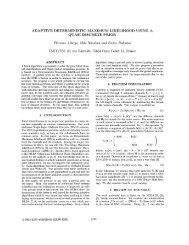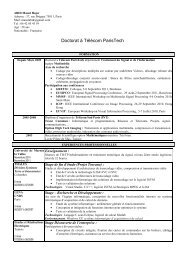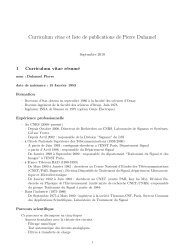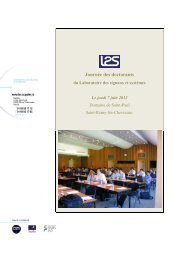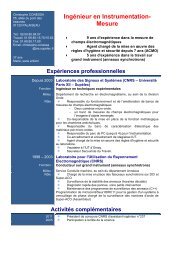THÈSE DE DOCTORAT Ecole Doctorale « Sciences et ...
THÈSE DE DOCTORAT Ecole Doctorale « Sciences et ...
THÈSE DE DOCTORAT Ecole Doctorale « Sciences et ...
You also want an ePaper? Increase the reach of your titles
YUMPU automatically turns print PDFs into web optimized ePapers that Google loves.
using the emulation of a continuous-time observer [2].<br />
Moreover, the behaviour of emulation states present a<br />
big overshoot by opposite to the results obtained by<br />
the observer (3a-d)-(4a-d). Obtained param<strong>et</strong>er estimates<br />
converge slowly asymptotically to the true value<br />
for the continuous-discr<strong>et</strong>e observer, and again, practically<br />
and with large overshoots for the emulation. Although<br />
not presented here, simulation results show that<br />
the continuous-time observer still works efficiently for<br />
larger values of τ like τ = 3 whereas, for such a value,<br />
the emulation states explose.<br />
x1<br />
100<br />
0<br />
−100<br />
x1 − ˆx1<br />
x2 − ˆx2<br />
x2 − ˆx2<br />
60<br />
40<br />
20<br />
0<br />
150<br />
100<br />
50<br />
0<br />
−50<br />
4<br />
2<br />
0<br />
t<br />
0 2 4 6 8 10 12 14 16 18 20<br />
t<br />
(3a-d)-(4a-d)<br />
emulation<br />
0 2 4 6 8 10 12 14 16 18 20<br />
t<br />
(3a-d)-(4a-d)<br />
(3a-d)-(4a-d)<br />
emulation<br />
0 2 4 6 8 10 12 14 16 18 20<br />
emulation<br />
−2<br />
1200 1250 1300 1350 1400 1450 1500<br />
t<br />
Figure 1. State x 1 and convergence of the state observation<br />
errors<br />
˜θ ˜θ<br />
10<br />
5<br />
0<br />
−5<br />
−10<br />
−15<br />
−20<br />
0 10 20 30 40 50 60 70 80 90 100<br />
2.1<br />
2.05<br />
2<br />
1.95<br />
1.9<br />
1.85<br />
t<br />
t<br />
x 1<br />
(3a-d)-(4a-d)<br />
emulation<br />
200 400 600 800 1000 1200 1400<br />
Figure 2. Convergence of the param<strong>et</strong>er estimate<br />
6 Conclusions<br />
The adaptive observation of a class of continuous MIMO<br />
systems with sampled measurements has been realized.<br />
Assuming the input acting on the system to satisfy some<br />
persistent excitation conditions and the sampling steps<br />
to respect given bounds, a class of global exponential<br />
observers has been developed.<br />
References<br />
[1] B.D.O. Anderson, R.R. Bitmead, C.R. Johnson, P.V.<br />
Kokotović, R.L. Kosut, I.M.Y. Mareels, L. Praly, and<br />
B.D. Riedle. Stability of Adaptive Systems: Passivity and<br />
Averaging Analysis. Signal Processing, Optimization and<br />
Control, MIT Press, Cambridge, U.S.A., 1986.<br />
[2] M. Arcak and D. Nešić. A framework for nonlinear sampleddata<br />
observer design via approximate discr<strong>et</strong>e-time models<br />
and emulation. Automatica, 40:1931–1938, 2004.<br />
[3] C.-M. Astorga, N. Othman, S. Othman, H. Hammouri, and<br />
T.-F. McKenna. Nonlinear continuous-discr<strong>et</strong>e observers:<br />
applications to emulsion polymerization reactors. Control<br />
Eng. Practice, 10:3–13, 2002.<br />
[4] G. Bastin and M. Gevers. Stable adaptive observers for<br />
nonlinear time varying systems. IEEE Trans. on Aut.<br />
Control, 33(7):650–658, 1988.<br />
[5] G. Besançon. Remarks on nonlinear adaptive observer design.<br />
Syst. & Control L<strong>et</strong>t., 41(7):271–280, 2000.<br />
[6] G. Besançon, J. De León-Morales, and O. Huerta-Guevara.<br />
On adaptive observers for state affine systems. Int. J. of<br />
Contr., 79(6):581–591, 2006.<br />
[7] E. Bıyık and M. Arcak. A hybrid redesign of newton observers<br />
in the absence of an exact discr<strong>et</strong>e-time model. Systems &<br />
Control L<strong>et</strong>ters, 55:429–436, 2006.<br />
[8] G. Bornard, F. Celle, and N. Couenne. Regularly persistent<br />
observers for bilinear systems. In Proc. of the 29th<br />
International Conference on Nonlinear Systems, New Trends<br />
in Nonlinear Systems Theory, volume 122, pages 130–140,<br />
Nantes, France, 1988.<br />
[9] F. Celle, J.P. Gauthier, D. Kazakos, and G. Sall<strong>et</strong>. Synthesis<br />
of nonlinear observers: a harmonic-analysis approach. Math.<br />
Syst. Theory, 22:291–322, 1989.<br />
[10] Y. M. Cho and R. Rajamani. A systematic approach to<br />
adaptive observer synthesis for nonlinear systems. IEEE<br />
Trans. on Aut. Control, 42:534–537, 1997.<br />
[11] A.M. Dabroom and H.K. Khalil. Output feedback sampleddata<br />
control of nonlinear systems using high-gain observers.<br />
IEEE Trans. on Aut. Control, 46(11):1712–1725, 2001.<br />
[12] F. Deza, E. Busvelle, J.P. Gauthier, and D. Rakotopora.<br />
High gain estimation for nonlinear systems. Sys. & Control<br />
L<strong>et</strong>t., 18:295–299, 1992.<br />
[13] H. Hammouri, P. Kabore, S. Othman, and J. Biston. Failure<br />
diagnosis and nonlinear observer. application to a hydraulic<br />
process. J. of the Franklin Institute, 339:455–478, 2002.<br />
[14] H. Hammouri and J. DeLeon Morales. Chapter: Topological<br />
properties of observer’s inputs. In Progress in Syst. and<br />
Control Theory, Birkhauser, Boston, U.S.A., 2002.<br />
[15] H. Hammouri, M. Nadri, and R. Mota. Constant gain<br />
observer for continuous-discr<strong>et</strong>e time uniformly observable<br />
systems. In Proc. of the 45th IEEE Conf. on Dec. & Control,<br />
pages 6240–6244, San Diego, U.S.A., 2006.<br />
[16] G. Kresselmeier. Adaptive observers with exponential rate of<br />
convergence. IEEE Trans. on Aut. Control, AC-22:2–8, 1977.<br />
[17] G. Lüders and K.S. Narendra. An adaptive observer and<br />
identifier for a linear system. IEEE Trans. on Aut. Control,<br />
AC-18:496–499, 1973.<br />
[18] R. Marino and P. Tomei. Adaptive observers with arbitrary<br />
exponential rate of convergence for nonlinear systems. IEEE<br />
Trans. on Aut. Control, 40:1300–1304, 1995.<br />
[19] R. Marino and P. Tomei. Nonlinear control design. ser.<br />
Information and system sciences, Prentice Hall, London,<br />
U.K., 1995.<br />
[20] P.E. Moraal and J.W. Grizzle. Observer design for nonlinear<br />
systems with discr<strong>et</strong>-time measurements. IEEE Trans. on<br />
Aut. Control, 40(3):395–404, 1995.<br />
6



